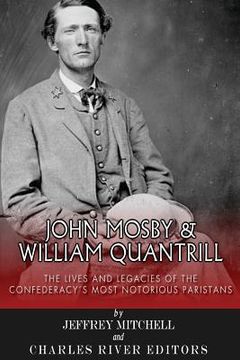John Mosby and William Quantrill: The Lives and Legacies of the Confederacy's Most Notorious Partisans (en Inglés)
Reseña del libro "John Mosby and William Quantrill: The Lives and Legacies of the Confederacy's Most Notorious Partisans (en Inglés)"
*Includes pictures. *Includes accounts of battles by the two partisan leaders and other important soldiers. *Includes footnotes and a bibliography of each for further reading. The Civil War is best remembered for the big battles and the legendary generals who fought on both sides, like Robert E. Lee facing off against Ulysses S. Grant in 1864. In kind, the Eastern theater has always drawn more interest and attention than the West. However, while massive armies marched around the country fighting each other, there were other small guerrilla groups that engaged in irregular warfare on the margins, and perhaps the most famous of them was Colonel John Mosby and William Quantrill. Mosby, the "Gray Ghost" of the Confederate lore that celebrates the Lost Cause, has an image that has proven nearly impossible to corrupt or change, and time has done little good against it. Unlike the vanished 19th century code of honor that he represented, Mosby has retained the image and all its connotations; evident in the pictures taken of him in his Confederate uniform and historical portrayals of him, whether they were written just after the Civil War or much later. But that image, which he helped fashioned, was mostly an invention. While the South would come to idolize "Southern gentlemen" as epitomized by Robert E. Lee, Mosby operated under a far different nature. Though he enlisted with the Confederate army in Virginia after Fort Sumter, he ultimately left the infantry to join J.E.B. Stuart's cavalry, and he later became infamous as an irregular scout leading a group of rangers around Virginia. Of course, the successful feats of daring that Mosby would accomplish during the war, which included capturing a Union general and riding around behind enemy lines to raid and destroy supplies, were supported by the people of Virginia, thus legitimizing his unconventional move to leave army life. Mosby not only earned the nickname "Gray Ghost" by being elusive, he was so successful that part of Virginia was known as "Mosby's Confederacy" during the war, despite the presence of massive Union armies nearby. Quantrill's Raiders operated along the border between Missouri and Kansas, which had been the scene of partisan fighting over a decade earlier during the debate over whether Kansas and Nebraska would enter the Union as free states or slave states. In "Bloody Kansas", zealous pro-slavery and anti-slavery forces fought each other, most notably John Brown, and the region became a breeding ground for individuals like Quantrill who shifted right back into similar fighting once the Civil War started. Rather than target military infrastructure or enemy soldiers, the bushwhackers rode in smaller numbers and targeted civilians on the other side of the conflict, making legends out of men like Bloody Bill Anderson and John Mosby. However, none are remembered like Quantrill and his men, not only because of their deeds during the Civil War but because of the actions of some of the former Raiders after it. Quantrill is best known for raiding Lawrence, Kansas in August 1863 and slaughtering nearly 200 boys and men between the ages of 14-90, under the pretext that they were capable of holding a gun and thus helping the Union cause. After that massacre, Union forces in the area retaliated in similar fashion, forcing Southern sympathizers out of several counties in the area and burning the property. Union forces also detained those accused of assisting Quantrill's Raiders, including their relatives. Quantrill himself was killed while fighting in June 1865, nearly two months after Lee surrendered to Grant at Appomattox, but his name was kept alive by the notorious deeds of his Raiders during the war and the criminal exploits of former Raiders like Jesse James and his brother, as well as the Younger brothers. These men, who had fought with Quantrill, became some of America's most famous outlaws.

